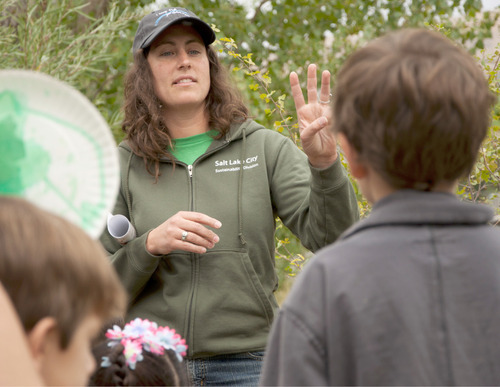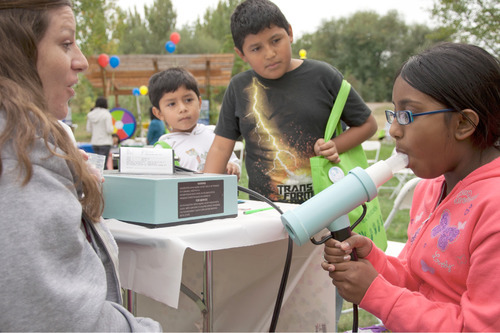This is an archived article that was published on sltrib.com in 2010, and information in the article may be outdated. It is provided only for personal research purposes and may not be reprinted.
A foul stench sometimes wafts through the windows of Blanca Revolorio's home in the Rose Park section of Salt Lake City.
She asked the company that built her home about the fish-like smell, but got no help. And with just limited English skills, Revolorio was at a loss to know where to find help.
On Saturday, that may have changed. Revolorio, with a son in tow, attended a children's health fair on the grounds of the Day-Riverside Library, where people representing eight local, state and federal agencies were on hand to answer questions and hand out information in English and Spanish.
"In the afternoons, there is a very bad smell. She cannot keep her windows open at night because of the smell," said Alicia Aalto, a children's health coordinator for the Environmental Protection Agency, who served as an interpreter for Revolorio.
"She's concerned because she's heard that some of the people [in Revolorio's] neighborhood got cancer. She's worried that some of those bad smells may come from factories in the area," Aalto said.
Aalto pointed out representatives of the Utah Department of Environmental Quality and the Salt Lake Valley Health Department, who were also at the fair. Revolorio said she might visit them.
The health fair was put together by the three agencies, with assistance from Salt Lake City, the Utah Society for Environmental Education, the Multicultural Health Network, Jordan Meadows Community Council and Envision Utah.
Together, the organizations used the fair to launch a children's environmental health and justice initiative that will focus on several neighborhoods in central and west Salt Lake City.
The neighborhoods — People's Freeway, Capitol Hill, downtown-Rio Grande, Glendale, Jordan Meadows, Poplar Grove, Rose Park, State Fairpark and Westpointe-West Salt Lake — were selected because of the presence of several environmental risk factors, said Stacee Adams, an environmental planning consultant at the Department of Environmental Quality.
"This area historically has had some environmental problems because the industry [in north Salt Lake County] is right here," Adams said, noting that in the past a network of canals drained oil into the Great Salt Lake and a sludge pit existed in the heart of Rose Park.
The neighborhoods also have a record of addressing environmental issues. That attracted the attention of the EPA's Denver region office, which was looking for somewhere in its six-state territory to start a health initiative aimed at children, said Debra Thomas, the EPA's deputy assistant regional administrator in Denver.
"Child health and environmental justice are high priorities" for the EPA. "Their bodies are developing, and they react differently to toxins," Thomas said.
"If you look at the children around here, and their size, they eat, drink and breathe a lot more than adults, relative to their size. Their brains and organs are developing and aren't established yet," she said.
That puts them at risk for developing asthma and other ailments that could dog them for the rest of their lives, said Gary Edwards, executive director of the Salt Lake Valley Health Department.
"We can't just think of children as little adults. Their systems are still developing and growing," he said.
Robert Maturana, a Peruvian immigrant who runs a program that prepares minority children for higher education through a soccer-based mentoring program, said he came to the fair out of concern for his daughter's health.
"So many times at school, my daughter couldn't go out because of the air pollution," Maturana said. "Based on my studies and research, children consume more air when they practice sports than adults."
Thomas said the initiative partners plan to ask residents of the central and west Salt Lake City neighborhoods what they think the biggest health-related environmental problems in their areas are.
She said the partners will use the results to develop a plan to address the problems. The plan should be ready by next spring.







